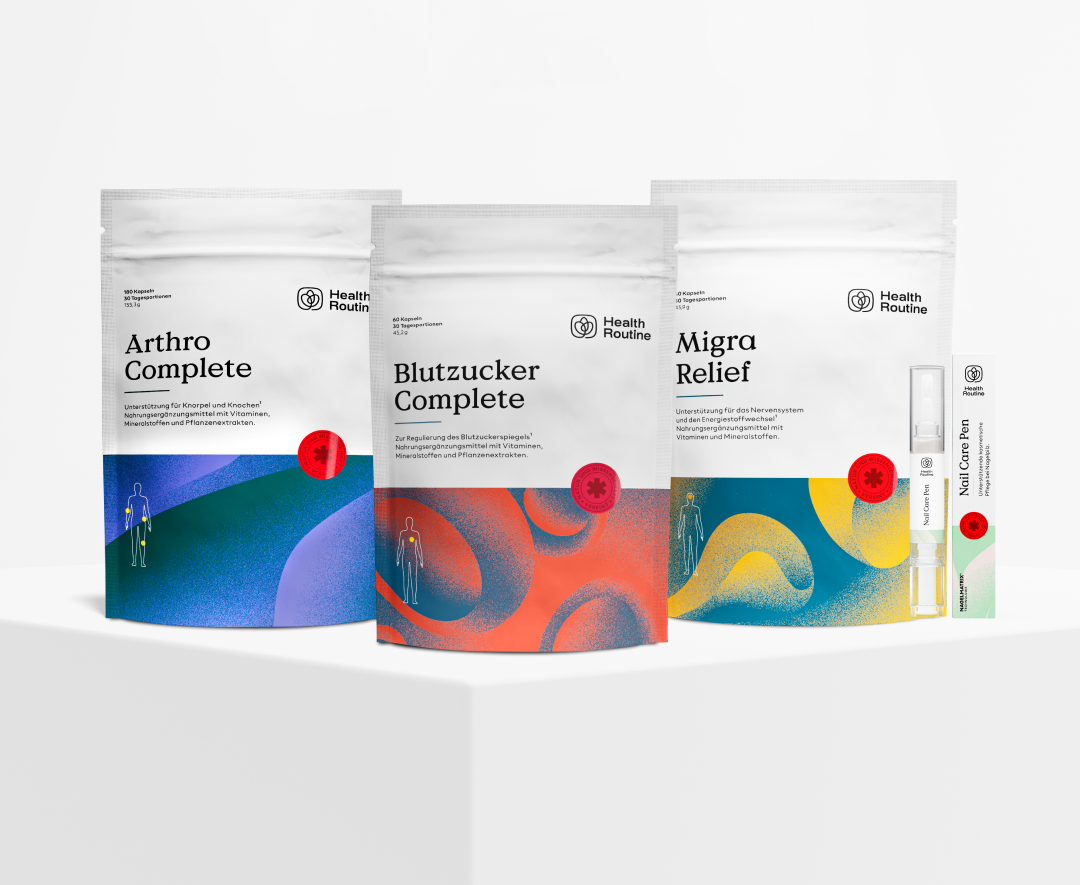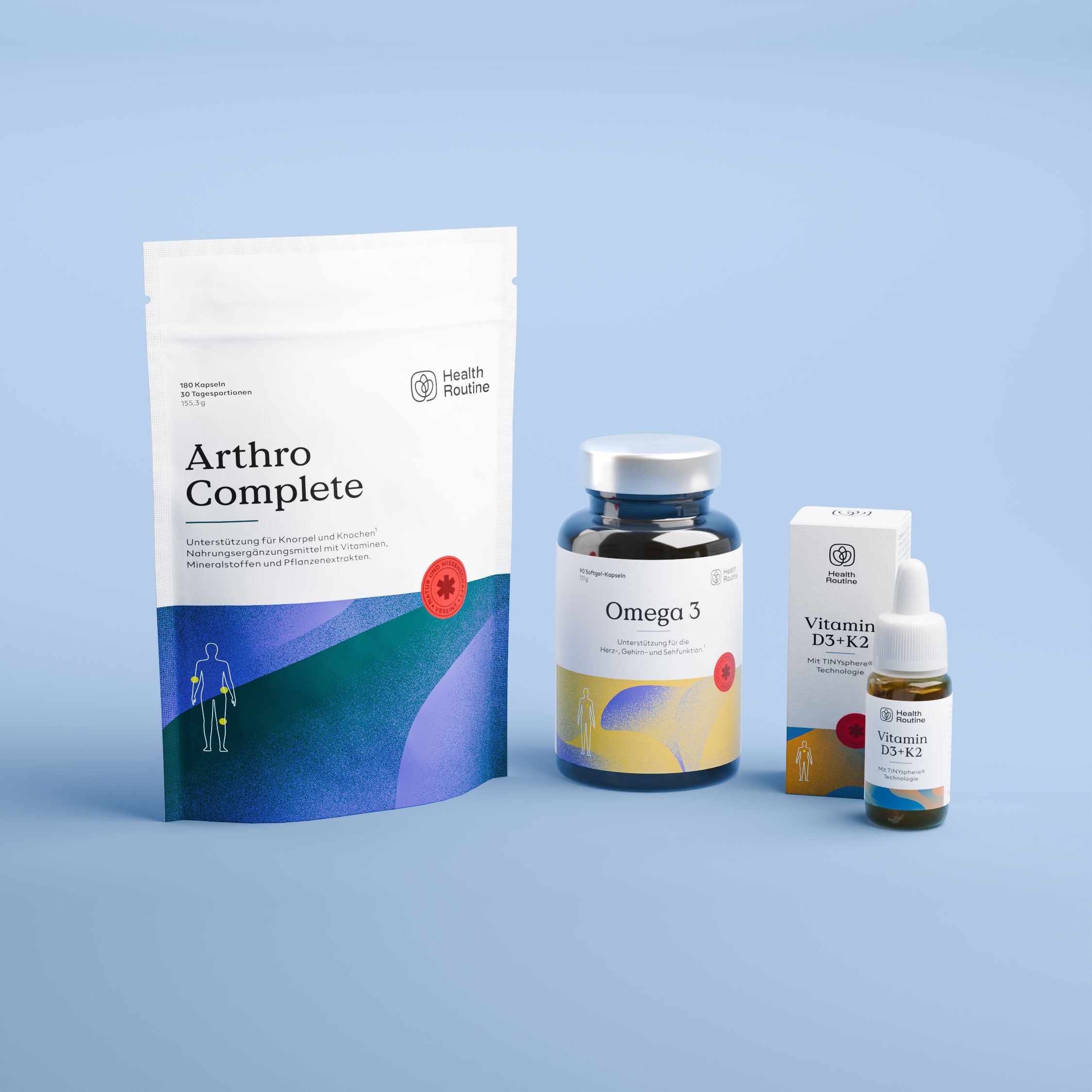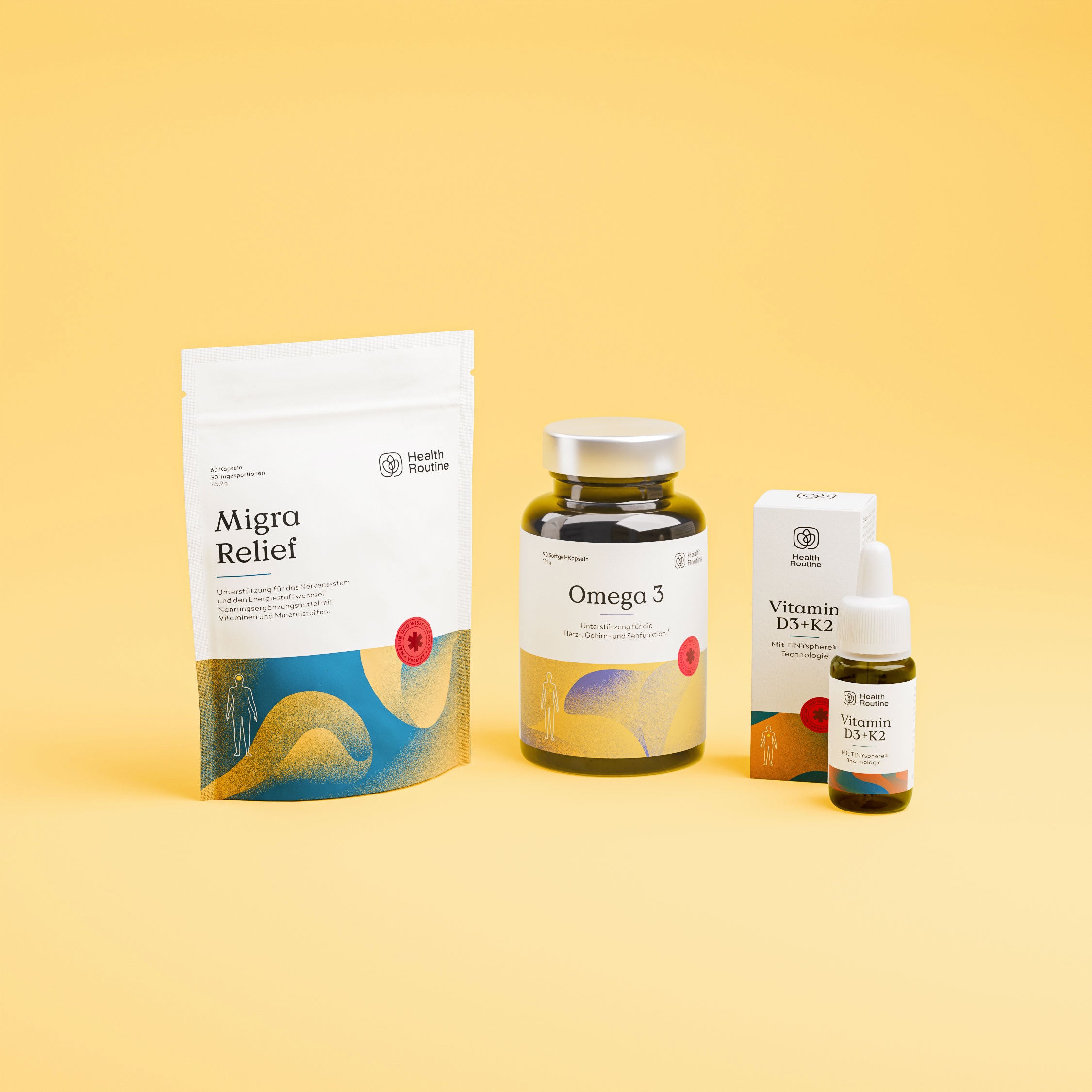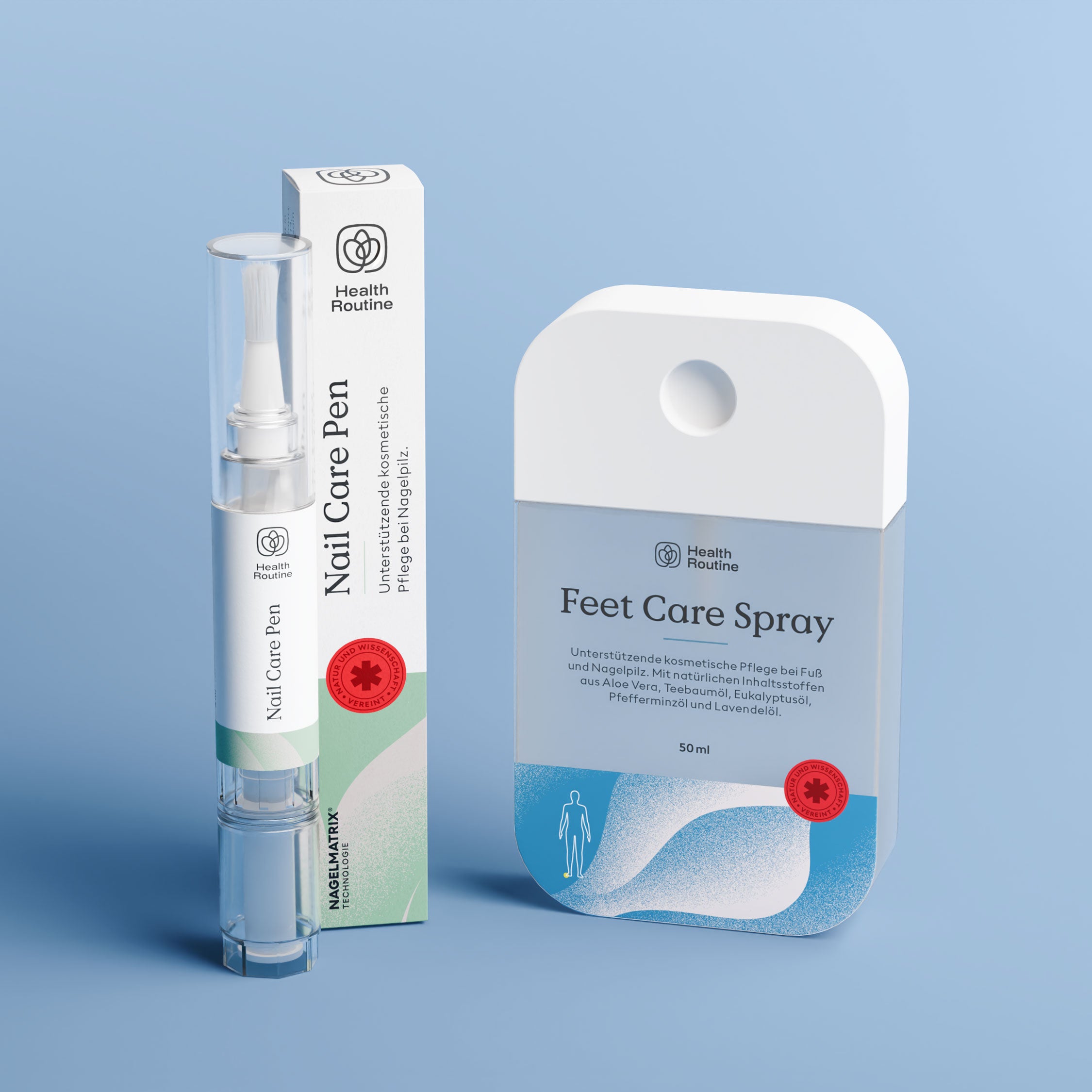A hot, sore finger and maybe even a throbbing feeling – these are symptoms that many have experienced.

Schutz, Pflege & Hygiene bei Fuß- und Nagelpilz
Ideal für die tägliche Pflege der Füße
Bestehend aus natürlichen Wirkstoffen
Could the nail fold be inflamed? Inflammation of the nail fold can not only be uncomfortable but also interfere with our daily activities.
In order to treat inflammation of the nail fold quickly and effectively, it is crucial to know the causes and triggers exactly and to take the right steps.
In this article, we would like to give you the best tips for treating nail wall inflammation.

Different forms of nail inflammation
Nail infections can affect different areas of the nail and result in different symptoms and treatment approaches .
In this section, we will look at the specific areas of the nail that can be affected by inflammation and explain how this inflammation manifests itself.
What are paronychia?
Paronychia, also known as paronychia , affects the skin around the nail, the nail fold.
This area protects the nail and can become inflamed due to injury or infection , causing pain, swelling, and sometimes pus.
Early detection and treatment is crucial to prevent the infection from spreading.
What are paronychia?
An inflammation of the nail bed, also called onychia , occurs when the nail bed – the skin under the nail – is inflamed.
This inflammation can be caused by bacteria or fungi or by injuries such as pinching or ingrown nails.
Typical symptoms are pain, redness and swelling around the nail.
What are nail fold infections?
Nail fold infections affect the nail fold, the area where the nail meets the skin.
They can be caused by mechanical irritation, infections or chemical influences and are expressed by
- Redness,
- Swelling and
- Pain in the affected area.
What are nail root infections?
The nail root, the part of the nail that lies under the skin at the bottom of the nail and is responsible for nail growth , can also become inflamed.
Inflammation in this area can impair nail growth and is often associated with pain.
The most common symptoms of nail wall inflammation
Inflammation of the nail wall, also known as paronychia, is not only unpleasant but can also be an indication of deeper infections .
They occur when the nail fold, the skin around the nail, is inflamed.
This can lead to a range of symptoms, ranging from mild discomfort to clear signs of infection .
A swollen nail fold is a common and noticeable symptom that should be taken seriously.
Common symptoms of nail wall inflammation:
-
Pain in the affected area: This is often the first sign of inflammation. Pain can range from mild discomfort to severe, throbbing pain, especially when pressure is applied.
-
Redness around the nail: The skin around the nail may appear red and inflamed, indicating infection or irritation.
-
A noticeably swollen nail fold: Swelling is a clear sign of inflammation and can impair the mobility of the finger or toe.
-
Sensitivity to touch or pressure: The affected area may be particularly sensitive to touch or pressure, making everyday activities difficult.
-
Pus formation or purulent discharge: The presence of pus is a sign of a bacterial infection and often requires medical treatment.
-
Increased warmth in the inflamed area: The affected area may feel warmer than the surrounding skin, indicating active inflammation.
- Changes in nail color or texture: Discoloration or changes in the structure of the nail may indicate an advanced infection or other nail disease.
These symptoms may occur individually or in combination and should be considered warning signs of a possible infection.
Early treatment can help prevent the spread of infection and speed up healing.
All causes of inflammation at a glance
There are various causes of nail infections, and understanding these factors is crucial to effectively preventing and treating them.
Nail infections often occur as a result of injuries , for example cutting the nails too short or improper nail care .
Ingrown nails can also cause inflammation. Another important cause is poor hygiene , which increases the risk of bacterial or fungal infections.
Regular and careful cleaning of hands and nails is therefore essential to minimize the risk of nail inflammation.
How do you effectively treat a nail wall infection?
Treatment for paronychia , also known as paronychia, varies depending on the severity of the symptoms.
In mild cases, simple home remedies and self-help measures may be sufficient to relieve the inflammation and the associated symptoms.
More severe cases, which may develop into panaritium—a deeper infection of the finger—may require more specific treatment from a doctor.
Surgical treatment
In rare cases, when a nail wall infection is particularly persistent or recurs despite treatment, surgical intervention may be considered .
This step is carefully considered and is usually only used when other treatment methods have not achieved the desired result .
This procedure involves surgically treating the affected nail area to reduce inflammation and promote rapid healing.
Such procedures are always performed by experienced doctors who ensure that the procedure is as gentle as possible.
What can you do yourself to combat the inflammation?
There are various ways to treat nail wall inflammation at home and alleviate its progression.
Here are some best practices:
-
Cleanliness and dryness: Keep the affected area clean and dry. This prevents the penetration of further bacteria and promotes healing.
-
Avoid pressure: Wear loose shoes or avoid pressure on the affected nail to reduce pain and prevent the inflammation from worsening.
-
Warm compresses: Apply warm compresses to the inflamed area to reduce swelling and promote blood circulation.
-
Saltwater baths: Regularly immerse the affected foot or hand in a warm saltwater bath. This can help reduce inflammation and relieve pain.
-
Rest: Avoid excessive strain on the affected area. Give your body time to heal.
-
Moisturizing creams: Use moisturizing creams to keep the skin around the nail supple and prevent cracking or dryness.
- Nail care: Avoid cutting cuticles or tearing nails. Gentle nail care can prevent further injury.
It is important to note that while these home remedies may relieve symptoms, medical consultation is still recommended in case of severe pain or complications.

10 proven methods to prevent infections
To reduce the risk of nail infection, there are some preventative measures you can take.
Here are 10 proven methods to prevent infections :
- Do not cut your nails too short.
- Use clean instruments when cutting nails.
- Make sure you take good care of your nails, including filing them regularly.
- Keep your hands and feet clean and dry.
- Make sure you wear the right footwear and avoid shoes that are too tight.
- Wear bathing shoes in public swimming pools.
- Avoid biting your nails .
- Do not use harmful nail polishes or nail products.
- Make sure that nail salons maintain hygiene standards.
- Avoid contact with infected people or objects.
Insider tip: Experience the power of our foot bath salt for your nail care
Treat your feet and nails to an extra dose of care with our specially developed foot bath salts from Health Routine . This unique bath salt is not only a treat for tired feet, but also an effective aid in cosmetic care and the prevention of nail infections.
The power of nature in every pinch:
-
Sea salt: This natural ingredient is known for its cleansing and soothing properties, which can help relax and nourish the skin.
-
Baking soda: With its alkaline qualities, baking soda helps maintain and promote the skin's natural balance.
-
Tea tree oil: This essential oil is a true all-rounder with antimicrobial properties, ideal for the care of nails and skin.
-
Eucalyptus oil: Refreshing and cleansing, eucalyptus oil supports skin health with its antimicrobial properties.
- Peppermint oil: For a cooling and soothing effect that invigorates and relaxes the skin.
Easy application for maximum effect:
Prepare a relaxing foot bath by dissolving 2-3 tablespoons of our foot bath salt in 3-4 liters of warm water (ideally at 36-38 °C).
Soak your feet for at least 10 minutes to experience the full benefits of the natural ingredients. Each pack provides you with 3-4 such relaxing foot baths.
Pamper your feet and nails with this special care and feel how the foot bath salt from Health Routine refreshes and regenerates your feet.
When should you seek medical treatment for a nail wall infection?
Many cases of paronychia can be treated well at home. However, there are certain signs that warrant medical advice. Pay particular attention to the following symptoms:
✘ Severe pain: When the pain is so intense that it interferes with your daily activities.
✘ Persistent symptoms: When the inflammation and associated symptoms persist for more than two weeks.
✘ Worsening of symptoms: An increase in redness, swelling, or pain, especially if pus forms or the inflammation spreads.
✘ Fever or general malaise: These may be signs of a spreading infection.
In these cases, the doctor can perform a more detailed examination and recommend the most appropriate treatment for your specific case.
Early medical advice can help prevent complications and promote a quick recovery.
Medical measures: What is done?
There are various medical measures available for the treatment of nail inflammation, which are adapted depending on the type and severity of the inflammation.
The most common treatment methods include:
-
Antibiotics: Prescribed when a bacterial infection is present. These medications help fight the bacteria and reduce inflammation.
-
Antifungals: Required for fungal infections. These medications specifically target fungi and support the healing of the nail bed.
-
Surgical intervention: In severe cases, it may be necessary to remove the affected nail tissue. This is usually done under local anesthesia and serves to relieve inflammation and prevent further spread of the infection.
- Advice and prevention: The doctor will also provide advice on proper nail care to prevent future infections. This includes tips on nail hygiene, proper nail trimming, and avoiding risk factors.
In addition, the doctor can also recommend supportive measures, such as warm foot baths or special ointments that promote the healing process and relieve discomfort.
How is a nail wall infection on the big toe treated?
Treating an inflamed toe, especially if it is an inflammation of the big toe, requires special attention.
Here are some steps you can take if you notice that your toe is inflamed:
➽ Conservative measures: For mild toe inflammation, warm foot baths, antiseptic ointments, and careful nail trimming can help relieve the inflammation and prevent further deterioration.
➽ Drug treatment: In cases of more severe inflammation, especially if the toe is severely inflamed and causes pain, antibiotics or antifungals may be necessary.
➽ Surgical procedures: In cases where the inflamed toe does not respond to conservative treatments, or if the inflammation of the big toe becomes chronic, partial removal of the nail may be necessary. This procedure relieves pressure on the inflamed area and promotes healing.
It's important to seek medical advice if symptoms persist or if you're unsure what to do if your toe is inflamed. Early treatment can help prevent complications and promote a speedy recovery.
Conclusion
Painful nail wall inflammation doesn't have to be part of your everyday life!
With the right care approaches and preventative measures, you can not only relieve symptoms but also help prevent future infections.
Remember to take good care of your nails and keep your hands and feet clean and dry at all times. If problems persist, don't hesitate to seek professional help.
At Health Routine, we understand the importance of healthy hands and feet for overall well-being.
With our specially developed products for hand and foot care, we would like to support you in your cosmetic nail care every day.
Discover our selection of high-quality, natural care products and experience how they can enrich your daily routine and help you keep your nails healthy and pain-free.
FAQ
Can an inflammation of the nail wall be dangerous?
Yes, an untreated nail wall infection can be dangerous under certain circumstances.
If not treated in time, the infection can spread and lead to more serious problems such as bone infection.
In rare cases, it can even cause blood poisoning (sepsis). Therefore, it is important to seek medical attention early if signs of progressive nail inflammation occur.
How long does a nail wall infection last?
The duration of a nail wall infection depends on various factors, such as the cause of the inflammation and the type of treatment.
Improvement usually begins after a few days of treatment, but complete healing may take several weeks depending on the severity of the infection.
Consistent treatment and care are crucial for a quick recovery.
What happens if you don't treat a nail wall infection?
If an inflammation of the nail wall is not treated, it can worsen and lead to complications.
The infection can spread to surrounding areas, causing increased inflammation, increased pain, and possibly abscesses.
In severe cases, permanent damage to the nail or surrounding tissue can occur, which can lead to long-term problems.
🌿 Discover more guides from Health Routine now:
- Treating nail fungus: symptoms, remedies and tips
- The nail bed in focus » Anatomy and diseases
- Nail fold » Definition, anatomy and diseases
Your medical advice
Our products are not intended to diagnose, treat, cure, or prevent any disease. The information provided in this article is for informational purposes only and is not intended as a substitute for advice from your physician or other healthcare professional.
Furthermore, our products are not a substitute for medications or other treatments prescribed by your doctor or healthcare provider. Regardless of the due care taken, no liability or warranty is assumed for the
- Accuracy,
- topicality,
- completeness
- and availability of the information provided.
No legal claims can be made for any damages potentially resulting from the use and application of this information. Liability claims of any kind are excluded.






